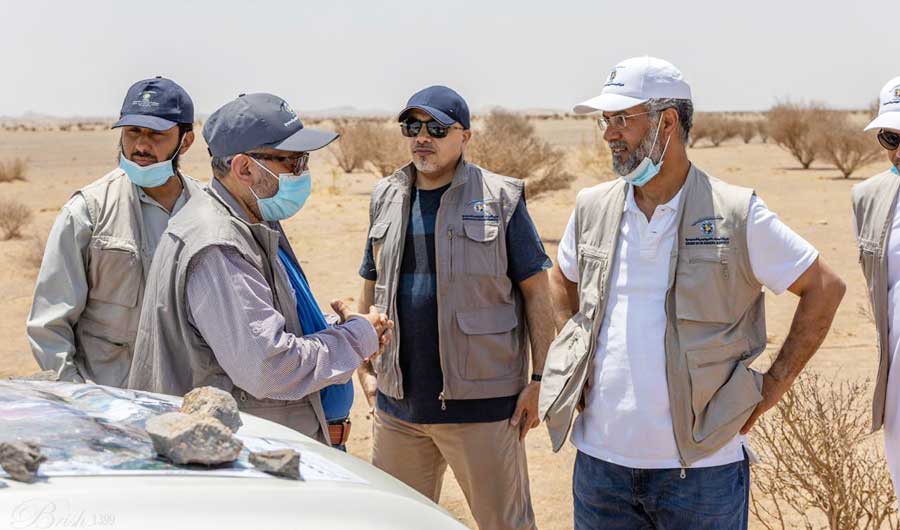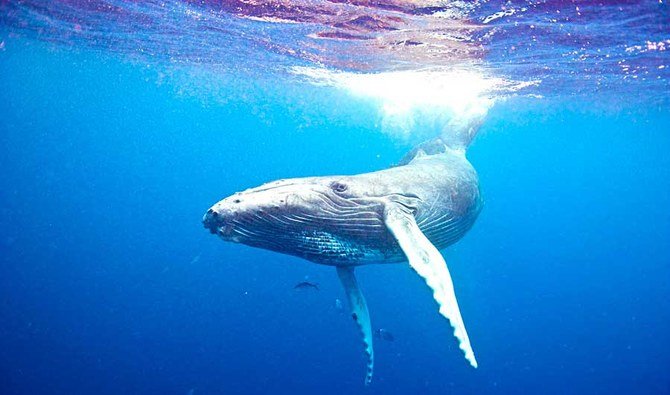
New discovery shines light on Saudi Arabia’s ancient marine environment
The discovery of the fossilized remains of an ancient whale that went extinct 37 million years ago in Saudi Arabia’s Jouf region has revealed secrets about the Kingdom’s geology and ancient marine environments.
The findings, made public on June 29, include a graveyard of fossilized whalebones that were uncovered by a group of eight local and international geologists and paleontologists.
A Saudi Geological Survey (SGS) team has taken credit for the discovery, which has been hailed as highly significant to science. The fossilized whale was found in an area filled with sandy and rocky mountains belonging to the Priabonian period, known as Upper Eocene Era, which dates back 37 million years.
The discovery will shine light on the geographical distribution of ancient marine mammals in northwestern Saudi Arabia.
In an interview with Iyad Zalmout, a US paleontology and geology technical adviser for the Saudi Geological Survey, and one of architects of the discovery, he told Arab News that the animal belongs to a rare species of archaic whale that is categorized under the extinct family archaeocetes.
The bone discovery includes a complete articulated vertebral column from the end of the tail to the upper chest, articulated forelimbs and shoulder blades, ribs, as well as parts of the skull and lower jaws.
Zalmout told Arab News: “This is one of the more derived whales than its earlier clans in having reduced rear limbs, forelimbs that are flattened to be more and less flip-like, a shortened neck, elongation of the trunk and a tail that is transformed into a fluke. The most important feature can be found in the skull, which shows very notable retreats of the nasal bones toward the forehead, and the reduction in the complexity of carnivorous-like cheek teeth.

“This new whale is similar in size and morphology to the partial skeleton of a small whale found back in 1902 and later in 1991 in the western desert of Egypt, called Stromerius nidensis. It was collected from the Upper Eocene rocks of the Fayum region. However, the new material from Saudi Arabia is more complete and will add more information to this group of whales,” he added. “At any rate, this whale is the smallest form of this whale family, half or maybe one-third the size of the Dorudon atrox.”
The mammal is a small-sized whale that measures about three meters long. Fully aquatic, with an elongated body, the tail may have evolved a fluke, and it has a serpentine-like body motion.
Scientists say that it would have weighed between 500 and 600 kilograms. “The weight is based on one specimen and rescaled from other whales found in the same geological time around the world,” Zalmout said.
The fossil was discovered in the Al-Rashrashiyah cliffs, a few kilometers north of the Qurayyat governorate, in the Kingdom’s northwest region near the Jordanian border.
Zalmout said that the area where the discovery was made is known to have high levels of rainwater accumulations, as “the fossil itself came from calcareous bituminous chalk and marl foothills.”
The Kingdom’s deserts are likely to contain many more aquatic mammal fossils, according to Zalmout.
“Whales and sea cows should be there, wherever Eocene and younger marine sediments are exposed. We have several Middle and Late Eocene rock units and formations exposed in Saudi Arabia (the Al-Rashrashiyah formation is one of these), and I am sure if you look and prospect carefully in these sediments, you will find marine mammals. According to my recollection, whales (archaeocetes) and sea cows (sirenians) were the only marine mammals that lived in the Eocene.”
Evolutionary timeline
The story of the origin of whales involves their evolution from a terrestrial ancestor, from where they adapted into a semi-aquatic marine inhibitor, and finally became fully aquatic.
Zalmout explained the three scenarios of marine mammal adaptation. “This history of great transformation and adaptation into fully aquatic life is a spectacular example of change, due to climatic change, which affects the surrounding ecosystems and the environments, and in turn will affect the food and reproduction cycle in these marine occupants.
“This may drive these animals through a number of different scenarios, including extinction, change of habitats and feeding behaviors and sources through adaptation, but not full adaption into marine life, and then finally going fully aquatic.”
He added: “I think marine mammals went through all three scenarios. Some early forms showed by the early Eocene quickly went extinct, some survived into semi-aquatic lives, and most of the living form whales are fully aquatic and will not return to land unless for a final destiny.”
The new discovery is the only Eocene whale discovered in the form of an almost complete skeleton in the Kingdom, Zalmout said.
“The SGS paleontology team is very optimistic that this will be a complete skeleton and will make appealing scientific research, and replicas of its skeleton will be displayed in local and international museums around the world.”
He added: “We are greatly thankful for the newly appointed SGS CEO Abdullah Al-Shamrani, and the past presidents for their effort and support to study the deep history of the Kingdom.”
The SGS is a specialized Saudi governmental agency empowered by an experienced and skilled paleontology team. Equipment, tools, and material used in SGS paleontology laboratories combine traditional paleontology methods and more advanced technology.
The group has contributed to several groundbreaking discoveries in paleontology in the past 15 years with the help of experienced local and international paleontology advisers, and scientific societies, including the Society of Vertebrate Paleontology and the Paleontological Society.


























